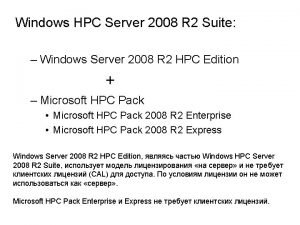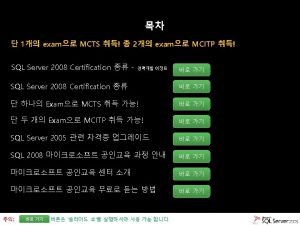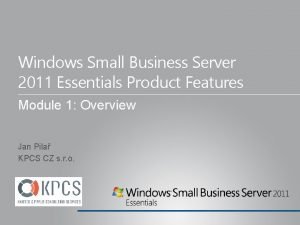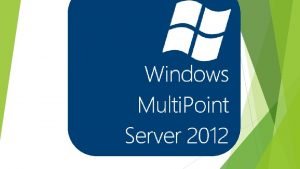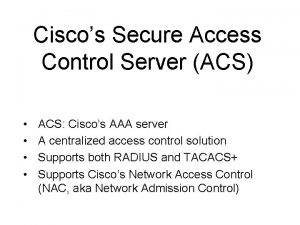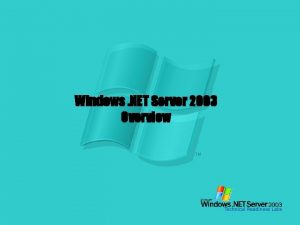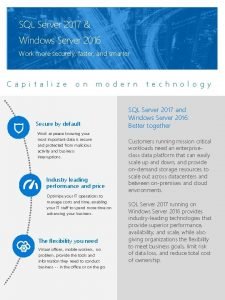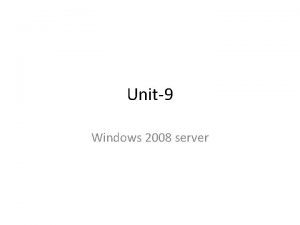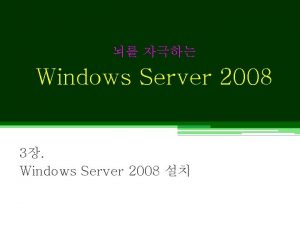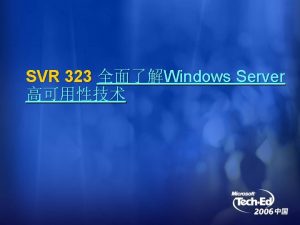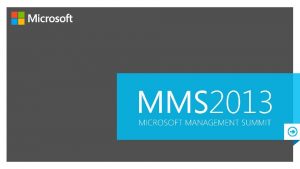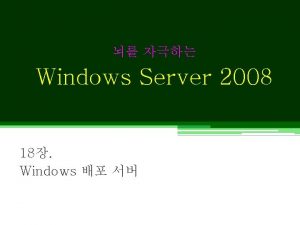Windows Server 2008 and Windows Server 2008 R


















- Slides: 18

Windows Server® 2008 and Windows Server 2008 R 2 Print Services Infrastructure Planning and Design Published: June 2010 Updated: November 2011

What Is IPD? Guidance that clarifies and streamlines the planning and design process for Microsoft® infrastructure technologies IPD: • Defines decision flow • Describes decisions to be made • Relates decisions and options for the business • Frames additional questions for business understanding IPD guides are available at www. microsoft. com/ipd

Getting Started Windows Server 2008 and Windows Server 2008 R 2 Print Services

Purpose and Overview Purpose • To provide design guidance for a Print Services infrastructure Overview • Print Services architecture • Print Services infrastructure design process

What’s New in Windows Server 2008 R 2 introduces new functionality and enhancements to Windows print services that provide improved performance, increased reliability, and greater flexibility for users, including the following: • Print migration enhancements • Printer driver isolation • Print administrator delegation • Print Management snap-in improvements • Client-Side Rendering (CSR) performance improvements • XML Paper Specification (XPS) print path improvements • Location-aware printing • Distributed Scan Server role service • Improvements to the Add Printer Wizard

Print Services Decision Flow MAP w/ CAL Tracker SCM ITA

Step 1: Determine the Scope of the Print Services Project • Task 1: Determine the Scope of the Project • Which parts of the organization will be participating • Which geographic areas within the organization will be included • Whether the scope extends beyond the boundaries of the organization, affecting external organizations • Task 2: Assess Special Printing Needs • Requirements for secure printing • Requirements for fault tolerance • Requirements for encryption

Step 2: Determine the Printers, Servers, and Clients That Will Be Included • Task 1: Inventory Existing Print Servers • • Server name Server location Server storage capacity (used and free) Whether the server uses a separate spool drive to improve performance • Task 2: Inventory Existing Print Devices • • • Location Printer Make/model Printer type Server • Task 3: Inventory Clients • Number of Print Server clients • Client operating systems in use • Print job characteristics

Step 3: Design the Print Services Infrastructure • Task 1: Determine How Many Print Servers Will Be Needed • Capacity and scalability are key factors in planning the deployment of print servers • Task 2: Determine Print Server Placement • Place client, print server, and print devices on the same local area network (LAN) for best printing performance • Task 3: Design Server Hardware • Can scale up or scale out

Step 3: Design the Print Services Infrastructure (Continued) • Task 4: Design Server Fault Tolerance • Server clustering • Fault-tolerant storage • Redundant network connections • Task 5: Determine Whether Printer Pools Will Be Used for Fault Tolerance • Printer pools can simplify administration and provide fault tolerance • Task 6: Design Printer Pools • There is no limit to the number of printers that can be in a pool

Summary and Conclusion • This guide has outlined the step-by-step process for planning a Print Services infrastructure. In each step, major decisions relative to the Print Services infrastructure were determined and described. The guide has explained how to define the goals and scope of the project, assess the current Print Services infrastructure, and design a new Print Services infrastructure, which can then be made available to the infrastructure planners. • Provide feedback to ipdfdbk@microsoft. com

Find More Information • Download the full document and other IPD guides: www. microsoft. com/ipd • Contact the IPD team: ipdfdbk@microsoft. com • Access the Microsoft Solution Accelerators website: www. microsoft. com/technet/Solution. Accelerators

Questions?

Addenda • Benefits of using the Print Services guide • IPD in Microsoft Operations Framework 4. 0 • Print Services in Microsoft Infrastructure Optimization

Benefits of Using the Print Services Guide • Benefits for Business Stakeholders/Decision Makers • Most cost-effective design solution for implementation • Alignment between the business and IT from the beginning of the design process to the end • Benefits for Infrastructure Stakeholders/Decision Makers • Authoritative guidance • Business validation questions ensuring solution meets requirements of business and infrastructure stakeholders • High integrity design criteria that includes product limitations • Fault-tolerant infrastructure • Proportionate system and network availability to meet business requirements • Infrastructure that’s sized appropriately for business requirements

Benefits of Using the Print Services Guide (Continued) • Benefits for Consultants or Partners • Rapid readiness for consulting engagements • Planning and design template to standardize design and peer reviews • A “leave-behind” for pre- and post-sales visits to customer sites • General classroom instruction/preparation • Benefits for the Entire Organization • Using the guide should result in a design that will be sized, configured, and appropriately placed to deliver a solution for achieving stated business requirements

IPD in Microsoft Operations Framework 4. 0 Use MOF with IPD guides to ensure that people and process considerations are addressed when changes to an organization’s IT services are being planned.

Print Services in Microsoft Infrastructure Optimization
 Ipam windows server 2008
Ipam windows server 2008 Windows server 2008
Windows server 2008 2008 2008
2008 2008 Sql server 2008 certification
Sql server 2008 certification Sql server 2008 management studio express
Sql server 2008 management studio express Sql server security best practices
Sql server security best practices Microsoft windows small business server 2011 essentials
Microsoft windows small business server 2011 essentials Microsoft windows small business server 2011 essentials
Microsoft windows small business server 2011 essentials Windows small business server 2003
Windows small business server 2003 Windows server 2000 caracteristicas
Windows server 2000 caracteristicas Multipoint dashboard
Multipoint dashboard Windows server migration tools
Windows server migration tools Windows storage server 2003
Windows storage server 2003 Secure access acs
Secure access acs Windows server codename longhorn
Windows server codename longhorn Networking with windows server 2016
Networking with windows server 2016 Windows net server family
Windows net server family Sql server 2017 windows 7
Sql server 2017 windows 7 Nouveauté windows server 2016
Nouveauté windows server 2016

